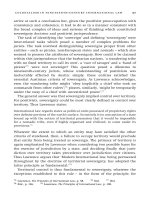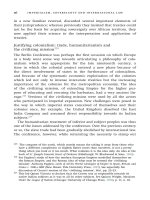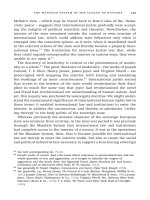Ebook Nursing informatics and the foundation of knowledge (4/E): Part 2
Bạn đang xem bản rút gọn của tài liệu. Xem và tải ngay bản đầy đủ của tài liệu tại đây (10.25 MB, 995 trang )
SECTIONIV:Nursing
InformaticsPractice
Applications:CareDelivery
Chapter14TheElectronicHealthRecordand
ClinicalInformatics
Chapter15InformaticsToolstoPromotePatient
SafetyandQualityOutcomes
Chapter16PatientEngagementandConnected
Health
Chapter17UsingInformaticstoPromote
Community/PopulationHealth
Chapter18TelenursingandRemoteAccess
Telehealth
Nursinginformationsystemsmustsupportnursesas
theyfulfilltheirrolesindeliveringqualitypatientcare.
Suchsystemsmustberesponsivetonurses’needs,
allowingthemtomanagetheirdataandinformationas
neededandprovidingaccesstonecessaryreferences,
literaturesources,andothernetworkeddepartments.
Nurseshavealwayspracticedinafieldwherethey
haveneededtousetheiringenuity,resourcefulness,
creativity,initiative,andskills.Toimprovepatientcare
andadvancethescienceofnursing,cliniciansas
knowledgeworkersmustapplythesesameabilities
andskillstobecomeastuteusersofavailable
informationsystems.
Inthissection,thereaderlearnsaboutclinicalpractice
tools,electronichealthrecords,andclinicalinformation
systems;informaticstoolstoenhancepatientsafety,
provideconsumerinformation,andmeeteducation
needs;populationandcommunityhealthtools;and
telehealthandtelenursing.
Informationsystems,electronicdocumentation,and
electronichealthrecordsarechangingthewaynurses
andphysicianspractice.Nursinginformaticssystems
arealsochanginghowpatientsenterandreceivedata
andinformation.Someinstitutions,forexample,are
permittingpatientstoaccesstheirownrecords
electronicallyviatheInternetoradedicatedpatient
portal.Confidentialityandprivacyissuesloomwith
thesenewelectronicsystems.HIPAAregulations
(coveredinthePerspectivesonNursingInformatics
section)andprofessionalethicsprinciples(coveredin
theBuildingBlocksofNursingInformaticssection)
mustremainattheforefrontwhencliniciansinteract
electronicallywithintimatepatientdataand
information.
Thematerialwithinthisbookisplacedwithinthe
contextoftheFoundationofKnowledgemodel(Figure
IV-1)tomeettheneedsofhealthcaredeliverysystems,
organizations,patients,andnurses.Readersshould
continuetoassesstheirpersonalknowledge
progression.TheFoundationofKnowledgemodel
challengesustoreflectonhowourknowledge
foundationisever-changingandtoappreciatethat
acquiringnewinformationisakeyresourcefor
knowledgebuilding.Thissectionaddressesthe
informationsystemswithwhichcliniciansinteractin
theirhealthcareenvironmentsasaffectedby
legislation,professionalcodesofethics,consumerism,
andreconceptualizationofpracticeparadigms,suchas
intelenursing.Allofthevariousnursingroles—
practice,administration,education,research,and
informatics—involvethescienceofnursing.
FigureIV-1FoundationofKnowledgeModel
DesignedbyAliciaMastrian
CHAPTER14:The
ElectronicHealthRecord
andClinicalInformatics
EmilyB.Barey,KathleenMastrian,andDeeMcGonigle
Objectives
1. Describethecommoncomponentsofan
electronichealthrecord.
2. Assessthebenefitsofimplementingan
electronichealthrecord.
3. Exploretheownershipofanelectronic
healthrecord.
4. Evaluatetheflexibilityoftheelectronic
healthrecordinmeetingtheneedsof
cliniciansandpatients.
KeyTerms
»Administrativeprocesses
»AmericanRecoveryandReinvestment
Actof2009(ARRA)
»Connectivity
»Decisionsupport
»Electroniccommunication
»Electronichealthrecords
»Healthinformation
»HealthInformationTechnologyfor
EconomicandClinicalHealthActof2009
(HITECH)
»Interoperability
»Meaningfuluse
»Orderentrymanagement
»Patientsupport
»Populationhealthmanagement
»Reporting
»Resultsmanagement
Introduction
Thesignificanceofelectronichealthrecords(EHRs)
tonursingcannotbeunderestimated.AlthoughEHRs
onthesurfacesuggestasimpleautomationofclinical
documentation,infacttheirimplicationsarebroad,
rangingfromthewaysinwhichcareisdelivered,tothe
typesofinteractionsnurseshavewithpatientsin
conjunctionwiththeuseoftechnology,totheresearch
surroundingEHRsthatwillinformnursingpracticefor
tomorrow.AlthoughEHRstandardsareevolvingand
barrierstoadoptionremain,thecollectiveworkhasa
positivemomentumthatwillbenefitcliniciansand
patientsalike.
AbasicknowledgeofEHRsandnursinginformaticsis
nowconsideredbymanytobeanentry-levelnursing
competency.Variousnursingworkgroupshave
delineatednursinginformaticscompetenciesfromentry
leveltonursinginformaticsspecialists,andother
groupshaveidentifiedcompetenciesspecifictothe
EHR.TheAmericanHealthInformationManagement
Association(AHIMA)collaboratedwiththeHealth
ProfessionsNetworkandtheEmploymentandTraining
Administrationtocreateagraphicdepictionof
competenciesnecessaryforEHRinteraction.The
ElectronicHealthRecordsCompetencyModelis
dividedintosixlevels:PersonalEffectiveness
Competencies,AcademicCompetencies,Workplace
Competencies,Industry-WideTechnicalCompetencies,
Industry-SectorTechnicalCompetencies,anda
ManagementCompetencieslevelsharedwith
OccupationSpecificRequirements.TheEHR
CompetencyModelcanbeviewedat:
www.careeronestop.org/CompetencyModel/competencymodels/electronic-health-records.aspx.Hovering
overeachblockinthemodelprovidesadefinitionof
eachofthecompetenciescoveredbythemodel.For
example,theindustry-sectortechnicalcompetencies
sectionincludeshealthinformationliteracyandskills,
healthinformaticsskillsusingtheEHR,privacyand
confidentialityofhealthinformation,andhealth
informationdatatechnicalsecurity.Thisdrivetoadopt
EHRswasunderscoredwiththepassageoftheHealth
InformationTechnologyforEconomicandClinical
HealthActof2009(HITECH).ItisessentialthatEHR
competencybedevelopedifnursesaretoparticipate
fullyinthechangingworldofhealthcareinformation
technology.
Thischapterhasfourgoals.First,itdescribesthe
commoncomponentsofanEHR.Second,itreviews
thebenefitsofimplementinganEHR.Third,itprovides
anoverviewofsuccessfulownershipofanEHR,
includingnursing’sroleinpromotingthesafeadoption
ofEHRsinday-to-daypractice.Fourth,itdiscussesthe
flexibilityofanEHRinmeetingtheneedsofboth
cliniciansandpatientsandemphasizestheneedfor
fullyinteroperableEHRsandclinicalinformation
systems(CISs).
SettingtheStage
TheU.S.healthcaresystemfacestheenormous
challengeofimprovingthequalityofcarewhile
simultaneouslycontrollingcosts.EHRswereproposed
asonesolutiontoachievethisgoal(Instituteof
Medicine[IOM],2001).InJanuary2004,President
GeorgeW.BushraisedtheprofileofEHRsinhisState
oftheUnionaddressbyoutliningaplantoensurethat
mostAmericanshaveanEHRby2014.Hestatedthat
“bycomputerizinghealthrecordswecanavoid
dangerousmedicalmistakes,reducecosts,and
improvecare”(Bush,2004).Thisproclamation
generatedanincreaseddemandforunderstanding
EHRsandpromotingtheiradoption,butrelativelyfew
healthcareorganizationsweremotivatedatthattimeto
pursueadoptionofEHRs.TheHealthcareInformation
andManagementSystemsSociety(HIMSS)hasbeen
trackingEHRadoptionsince2005throughits“Stage7”
award,andin2013reportedthatmostU.S.healthcare
organizations(77%)wereinStage3,reflectingonly
implementationofthebasicEHRcomponentsof
laboratory,radiology,andpharmacyancillaries;a
clinicaldatarepository,includingacontrolledmedical
vocabulary;andsimplenursingdocumentationand
clinicaldecisionsupport(HIMSS,2013).Higherstages
oftheelectronicmedicalrecordadoptionmodelinclude
moresophisticateduseofclinicaldecisionsupport
systems(CDSSs)andmedicationadministrationtools,
withHIMSSStage7—thehighestlevel—consistingof
EHRsthathavedatasharingandwarehousing
capabilitiesandthatarecompletelyinterfacedwith
emergencyandoutpatientfacilities(HIMSSAnalytics,
2013).Realprogressisbeingmadeontheadoptionof
morerobustEHRs.HIMSSAnalytics(2015)reports
that1,313hospitalsintheUnitedStateshaveachieved
Stage6withfullphysiciandocumentation,arobust
CDSS,andelectronicaccesstomedicalimages.
HealthcareITNews(2015)reportedthat,todate,over
200hospitalshaveachievedStage7andaretotally
paperless,andthatmoreorganizationsreachthisgoal
everyday.
InPresidentBarackObama’sfirstterminoffice,
CongresspassedtheAmericanRecoveryand
ReinvestmentActof2009(ARRA).Thislegislation
includedtheHITECHAct,whichspecificallysoughtto
incentivizehealthorganizationsandprovidersto
becomemeaningfulusersofEHRs.Theseincentives
cameintheformofincreasedreimbursementrates
fromtheCentersforMedicareandMedicaidServices
(CMS);ultimately,theHITECHActresultedinpayment
ofapenaltybyanyhealthcareorganizationthathad
notadoptedanEHRbyJanuary2015.Thefinalrule
waspublishedbytheDepartmentofHealthand
HumanServices(USDHHS)inJuly2010forthefirst
phaseofimplementation.Stage1meaningfuluse
criteriafocusedondatacaptureandsharing
(USDHHS,2010a).Stage2criteria,implementedin
2014,advancedseveralclinicalprocessesand
promotedhealthinformationexchange(HIE)andmore
patientcontroloverpersonaldata.Stage3,whichhas
atargetimplementationdateof2016,focuseson
improvedoutcomesforindividualsandpopulations,
andintroductionofpatientself-managementtools
(HealthIT.gov,2013).
ComponentsofElectronic
HealthRecords
Overview
BeforeenactmentoftheARRA,severalvariantsof
EHRsexisted,eachwithitsownterminologyandeach
developedwithadifferentaudienceinmind.The
sourcesoftheserecordsincluded,forexample,the
federalgovernment(CertificationCommissionfor
HealthcareInformationTechnology,2007),theIOM
(2003),theHIMSS(2007),andtheNationalInstitutes
ofHealth(2006;RobertWoodJohnsonFoundation
[RWJF],2006).UnderARRA,thereisnowanexplicit
requirementforprovidersandhospitalstousea
certifiedEHRthatmeetsasetofstandardfunctional
definitionstobeeligiblefortheincreased
reimbursementincentive.Initially,USDHHSgranted
twoorganizationstheauthoritytoaccreditEHRs:the
DrummondGroupandtheCertificationCommissionfor
HealthcareInformationTechnology.In2015,there
werefiverecognizedbodiesfortestingandcertifying
EHRs(HealthIT.gov,2015a).Thesebodiesare
authorizedtotestandcertifyEHRvendorsagainstthe
standardsandtestproceduresdevelopedbythe
NationalInstituteofStandardsandTechnology(NIST)
andendorsedbytheOfficeoftheNationalCoordinator
forHealthInformationTechnologyforEHRs.
TheinitialNISTtestprocedureincluded45certification
criteria,rangingfromthebasicabilitytorecordpatient
demographics,documentvitalsigns,andmaintainan
up-to-dateproblemlist,tomorecomplexfunctions,
suchaselectronicexchangeofclinicalinformationand
patientsummaryrecords(Jansen&Grance,2011;
NIST,2010).Box14-1liststhe45certificationcriteria
outlinedbyNISTin2010.Thesecriteriahavebeen
updatedseveraltimessince2010,withthe2015
versiondevelopedaftergoingoutforpubliccomment
(HealthIT.gov,2015b).Eachiterationofcertification
criteriaandtestingproceduresseekstomaketheEHR
morerobust,interoperable,andfunctionaltomeetthe
needsofpatientsandusers.
BOX14-1EHRCERTIFICATION
CRITERIA
Criteria#
CertificationCriteria
§170.302(a)
Drug–drug,drug–allergyinteractionchecks
§170.302(b)
Drugformularychecks
§170.302(c)
Maintainup-to-dateproblemlist
§170.302(d)
Maintainactivemedicationlist
§170.302(e)
Maintainactivemedicationallergylist
§170.302(f)
Vitalsigns
(1)
§170.302(f)
Calculatebodymassindex
(2)
§170.302(f)
Plotanddisplaygrowthcharts
(3)
§170.302(g)
Smokingstatus
§170.302(h)
Incorporatelaboratorytestresults
§170.302(i)
Generatepatientlists
§170.302(j)
Medicationreconciliation
§170.302(k)
Submissiontoimmunizationregistries
§170.302(l)
Publichealthsurveillance
§170.302(m)
Patient-specificeducationresources
§170.302(n)
Automatedmeasurecalculation
§170.302(o)
Accesscontrol
§170.302(p)
Emergencyaccess
§170.302(q)
Automaticlog-off
§170.302(r)
Auditlog
§170.302(s)
Integrity
§170.302(t)
Authentication
§170.302(u)
Generalencryption
§170.302(v)
Encryptionwhenexchangingelectronichealth
information
§170.302(w)
Accountingofdisclosures(optional)
§170.304(a)
Computerizedproviderorderentry
§170.304(b)
Electronicprescribing
§170.304(c)
Recorddemographics
§170.304(d)
Patientreminders
§170.304(e)
Clinicaldecisionsupport
§170.304(f)
Electroniccopyofhealthinformation
§170.304(g)
Timelyaccess
§170.304(h)
Clinicalsummaries
§170.304(i)
Exchangeclinicalinformationandpatientsummary
record
§170.304(j)
Calculateandsubmitclinicalqualitymeasures
§170.306(a)
Computerizedproviderorderentry
§170.306(b)
Recorddemographics
§170.306(c)
Clinicaldecisionsupport
§170.306(d)
Electroniccopyofhealthinformation
(1)
§170.306(d)
Electroniccopyofhealthinformation
(2)
Note:Fordischargesummary
§170.306(e)
Electroniccopyofdischargeinstructions
§170.306(f)
Exchangeclinicalinformationandpatientsummary
record
§170.306(g)
Reportablelabresults
§170.306(h)
Advancedirectives
§170.306(i)
Calculateandsubmitclinicalqualitymeasures
ReproducedfromNationalInstituteofStandardsandTechnology
(NIST).(2010).Meaningfulusetestmethod:Approvedtestprocedures
version1.0.Retrievedfrom
/>
DespitethepointsarticulatedintheARRA,theIOM
definitionofanEHRalsoremainsavalidreference
point.Thisdefinitionisusefulbecauseithasdistilledall
thepossiblefeaturesofanEHRintoeightessential
componentswithanemphasisonfunctionsthat
promotepatientsafety—auniversaldenominatorthat
everyoneinhealthcarecanaccept.Theeight
componentsare(1)healthinformationanddata,(2)
resultsmanagement,(3)orderentrymanagement,(4)
decisionsupport,(5)electroniccommunicationand
connectivity,(6)patientsupport,(7)administrative
processes,and(8)reportingandpopulationhealth
management(IOM,2003).Theseinitialcore
components,aswellasmorerecentmodifications
describedbytheHealthResourcesandServices
Administration(HRSA,n.d.)andthecomponentsofa
comprehensiveEHRidentifiedbyHealthIT.gov
(Charles,Gabriel,&Searcy,2015),aredescribedin
moredetailhere.WiththeexceptionofEHR
infrastructurefunctions,suchassecurityandprivacy
management,controlledmedicalvocabularies,and
interoperabilitystandards,the45initialNISTstandards
easilymapintotheIOMcategories(Jansen&Grance,
2011).
HealthInformationandData
Healthinformationanddatacomprisethepatientdata
requiredtomakesoundclinicaldecisions,including
demographics,medicalandnursingdiagnoses,
medicationlists,allergies,andtestresults(IOM,2003).
ThiscomponentoftheEHRalsoincludescare
managementdataregardingdetailsofpatientvisits
andinteractionswithpatients,medication
reconciliation,consents,anddirectives(HRSA,n.d.).A
comprehensiveEHRwillalsocontainnursing
assessmentsandproblemlists(Charles,Gabriel,&
Searcy,2015).
ResultsManagement
Resultsmanagementistheabilitytomanageresults
ofalltypeselectronically,includinglaboratoryand
radiologyprocedurereports,bothcurrentandhistorical
(IOM,2003).
OrderEntryManagement
Orderentrymanagementistheabilityofaclinicianto
entermedicationandothercareorders,including
laboratory,microbiology,pathology,radiology,nursing,
andsupplyorders;ancillaryservices;and
consultations,directlyintoacomputer(IOM,2003).A
comprehensiveEHRwillalsocontainnursingorders
(Charles,Gabriel,&Searcy,2015).
DecisionSupport
Decisionsupportentailstheuseofcomputer
remindersandalertstoimprovethediagnosisandcare
ofapatient,includingscreeningforcorrectdrug
selectionanddosing,screeningformedication
interactionswithothermedications,preventivehealth
remindersinsuchareasasvaccinations,healthrisk
screeninganddetection,andclinicalguidelinesfor
patientdiseasetreatment(IOM,2003).
ElectronicCommunicationand
Connectivity
Electroniccommunicationandconnectivityinclude
theonlinecommunicationamonghealthcareteam
members,theircarepartners,andpatients,including
email,Webmessaging,andanintegratedhealth
recordwithinandacrosssettings,institutions,and
telemedicine(IOM,2003).Thiscomponenthasbeen
expandedtoincludeinterfacesandinteroperability
requiredtoexchangehealthinformationwithother
providers,laboratories,pharmacies(e-prescribing),
patients,andgovernmentdiseaseregistries(HRSA,
n.d.,para.2)
PatientSupport
Patientsupportencompassespatienteducationand
self-monitoringtools,includinginteractivecomputerbasedpatienteducation,hometelemonitoring,and
telehealthsystems(IOM,2003).
AdministrativeProcesses
Administrativeprocessesareactivitiescarriedoutby
theelectronicscheduling,billing,andclaims
managementsystems,includingelectronicscheduling
forinpatientandoutpatientvisitsandprocedures,
electronicinsuranceeligibilityvalidation,claim
authorizationandpriorapproval,identificationof
possibleresearchstudyparticipants,anddrugrecall
support(IOM,2003).
ReportingandPopulationHealth
Management
Reportingandpopulationhealthmanagementare
thedatacollectiontoolstosupportpublicandprivate
reportingrequirements,includingdatarepresentedina
standardizedterminologyandmachine-readableformat
(IOM,2003).
NISThasnotprovidedanexhaustivelistofallpossible
featuresandfunctionsofanEHR.Consequently,
differentvendorEHRsystemscombinedifferent
componentsintheirofferings,andoftenasinglesetof
EHRcomponentsmaynotmeettheneedsofall
cliniciansandpatientpopulations.Forexample,a
pediatricsettingmaydemandfunctionsfor
immunizationmanagement,growthtracking,andmore
robustorderentryfeaturestoincludeweight-based
dosing(Spooner&CouncilonClinicalInformation
Technology,2007).Thesetypesoffeaturesmaynot
beprovidedbyallEHRsystems,anditisimportantto
considerEHRcertificationtobeaminimumstandard.
SeeFigure14-1foragraphicdepictionofEHR
functionsandcommunicationcapabilities.
Figure14-1EHRFunctionsandCommunication
Capabilities
ReproducedfromAmericanHospitalAssociation.(2010).Theroadto
meaningfuluse:WhatittakestoimplementEHRsystemsinhospitals.
Retrievedfrom />
AnothergroupthatfocusesonEHRstandardsand
functionalityisHealthLevelSevenInternational(HL7).
Foundedin1987,“HealthLevelSevenInternational
(HL7)isanot-for-profit,ANSI-accreditedstandards
developingorganizationdedicatedtoprovidinga
comprehensiveframeworkandrelatedstandardsfor
theexchange,integration,sharing,andretrievalof
electronichealthinformationthatsupportsclinical
practiceandthemanagement,deliveryandevaluation
ofhealthservices”(HealthlevelSevenInternational,
n.d.,para.1).Thisgroupconcentratesondeveloping
thebehind-the-scenesprogrammingstandards(Level
SevenistheapplicationleveloftheOpenSystems
Interconnectionmodel)forinterfacestoensure
interoperabilityandconnectivityamongsystems.
AdvantagesofElectronic
HealthRecords
MeasuringthebenefitsofEHRscanbechallenging.
PossiblemethodstoestimateEHRbenefitsinclude
usingvendor-supplieddatathathavebeenretrieved
fromtheircustomers’systems,synthesizingand
applyingstudiesofoverallEHRvalue,creatinglogical
engineeringmodelsofEHRvalue,summarizing
focusedstudiesofelementsofEHRvalue,and
conductingandapplyinginformationfromsitevisits
(HealthIT.gov,2012;Thompson,Osheroff,Classen,
&Sittig,2007).
Earlyon,thefourmostcommonbenefitscitedfor
EHRswere(1)increaseddeliveryofguidelines-based
care,(2)enhancedcapacitytoperformsurveillance
andmonitoringfordiseaseconditions,(3)reductionin
medicationerrors,and(4)decreaseduseofcare
(Chaudhryetal.,2006;HealthIT.gov,2012).These
findingswereechoedbytwosimilarliteraturereviews.
Thefirstreview(Dorretal.,2007)focusedontheuse
ofinformaticssystemsformanagingpatientswith
chronicillness.Itfoundthattheprocessesofcaremost
positivelyimpactedwereguidelinesadherence,visit
frequency(i.e.,adecreaseinemergencydepartment
visits),providerdocumentation,patienttreatment
adherence,andscreeningandtesting.
Thesecondreview(Shekelle,Morton,&Keeler,
2006)wasacost–benefitanalysisofhealthinformation
technologycompletedbytheAgencyforHealthcare
ResearchandQuality(AHRQ)thatstudiedthevalueof
anEHRintheambulatorycareandpediatricsettings,
includingitsoveralleconomicvalue.TheAHRQstudy
highlightedthecommonfindingsalreadydescribed,but
alsonotedthatmostofthedataavailableforreview
camefromsixleadinghealthcareorganizationsinthe
UnitedStates,underscoringthechallengeof
generalizingtheseresultstothebroaderhealthcare
industry.AsnotedpreviouslybytheHIMSSStage7
Awards,thechallengetogeneralizeresultspersistsin
thehospitalarena,withfewerthan1%ofU.S.hospitals
oreightleadingorganizationsprovidingmostofthe
experiencewithcomprehensiveEHRs(HIMSS,
2010a).Finally,theliteraturereviewscitedhere
indicatedthattherearealimitednumberofhypothesis-
testingstudiesofEHRsandevenfewerthathave
reportedcostdata.
Thedescriptivestudiesdohavevalue,however,and
shouldnotbehastilydismissed.Althoughnotas
rigorousintheirdesign,theydodescribethe
advantagesofEHRswellandoftenincludeuseful
implementationrecommendationslearnedfrom
practicalexperience.Asidentifiedinthesetypesof
reviews,EHRadvantagesincludesimplebenefits,
suchasnolongerhavingtointerpretpoorhandwriting
andhandwrittenorders,reducedturnaroundtimefor
laboratoryresultsinanemergencydepartment,and
decreasedtimetoadministrationofthefirstdoseof
antibioticsinaninpatientnursingunit(HealthIT.gov,
2012;Husk&Waxman,2004;Smithetal.,2004).In
theambulatorycaresetting,improvedmanagementof
cardiac-relatedriskfactorsinpatientswithdiabetes
andeffectivepatientnotificationofmedicationrecalls
havebeendemonstratedtobebenefitsoftheEHR
(Jainetal.,2005;Reed&Bernard,2005).Twoother
uniqueadvantagesthathavegreatpotentialarethe
abilitytousetheEHRanddecisionsupportfunctionsto
identifypatientswhoqualifyforresearchstudiesor
whoqualifyforprescriptiondrugbenefitsofferedby
pharmaceuticalcompaniesatsafety-netclinicsand
hospitals(Embietal.,2005;Poprock,2005).
TheHIMSSDaviesAwardmaybethebestresource
forcombinedquantitativeandqualitativeresultsof
successfulEHRimplementation.TheDaviesAward
recognizeshealthcareorganizationsthathave
achievedbothexcellenceinimplementationandvalue
fromhealthinformationtechnology(HIMSS,2010a).
Onewinnerdemonstratedasignificantavoidanceof
medicationerrorsbecauseofbar-codescanningalerts,
a$3milliondecreaseinmedicalrecordsexpensesas
aresultofgoingpaperless,anda5%reductionof
duplicatelaboratoryordersbyusingcomputerized
providerorderentryalerting(HIMSS,2010b).Another
winnernoteda13%decreaseinadversedrug
reactionsthroughtheuseofcomputerizedphysician
orderentry;italsoachievedadecreaseinmethicillinresistantStaphylococcusaureus(MRSA)nosocomial
infectionsfrom9.8per10,000dischargesto6.4per
10,000dischargesinlessthanayearusinganEHR
flaggingfunction,whichmadecliniciansimmediately
awarethatcontactprecautionswererequiredfor
MRSA-positivepatients(HIMSS,2009).Atboth
organizations,therewasqualitativeandquantitative
evidenceofhighratesofenduseradoptionand
satisfactionwithuseoftheEHR.
A2011studyoftheeffectsofEHRadoptiononnurse
perceptionsofqualityofcare,communication,and
patientsafetydocumentedthatnursesreportbetter
careoutcomesandfewerconcernswithcare
coordinationandpatientsafetyinhospitalswithabasic
EHR(Kutney-Lee&Kelly,2011).Inthisstudy,nurses
perceivedthatinhospitalswithafunctioningEHR,
therewasbettercommunicationamongstaff,
especiallyduringpatienttransfers,andfewer
medicationerrors.Baylissetal.(2015)demonstrated
thatanintegratedcaresystemutilizinganEHR
resultedinfewerhospitalreadmissionsandemergency
roomvisitsforover12,000seniorswithmultiplehealth
challenges.
WithoutanEHRsystem,anyofthesebenefitswould
beverydifficultandcostlytoaccomplish.Thus,despite
limitedstandardsandpublishedstudies,thereis
enoughevidencetoembracewidespread
implementationoftheEHR(Halamka,2006;
HealthIT.gov,2012),andcertainlyenoughevidenceto
warrantfurtherstudyoftheuseandbenefitsofEHRs.
Box14-2describessomeofthespecificCISfunctions
ofanEHR.
BOX14-2THEEHRASACLINICAL
INFORMATIONSYSTEM
DeniseTyler
ACISisatechnology-basedsystemappliedat
thepointofcareanddesignedtosupportcare
byprovidinginstantaccesstoinformationfor
clinicians.EarlyCISsimplementedpriortothe
adventofEHRswerelimitedinscopeand
providedsuchinformationasinterpretationof
laboratoryresultsoramedicationformularyand









